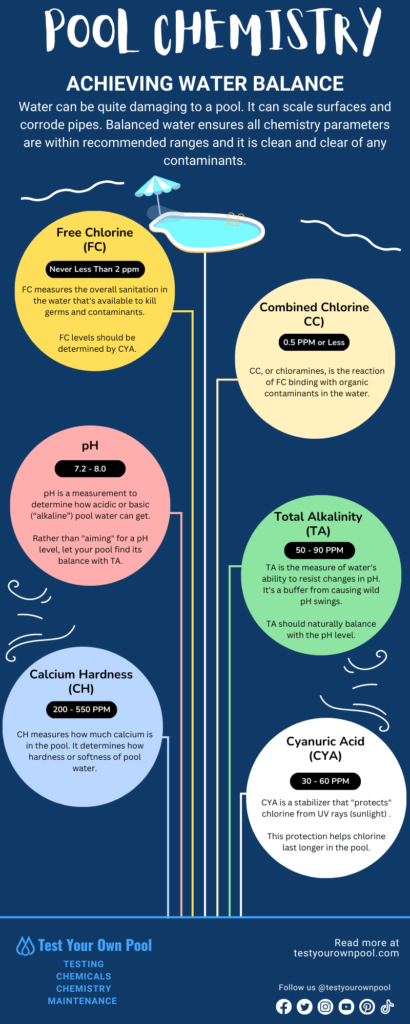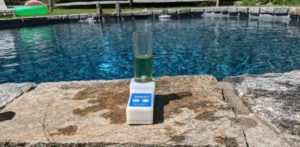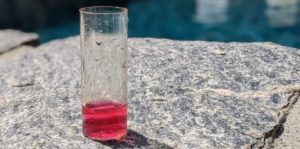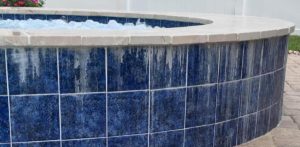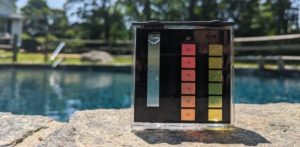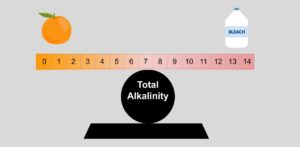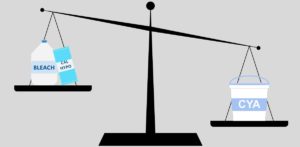When it comes to testing, you will know exactly what you are looking at. The same pool chemistry levels will be measured using a liquid drop-based testing kit or test strips.
It may seem tedious to continuously monitor your chemistry levels, but it’s better than the alternative of a green, cloudy pool in dire need of help.
These results will also determine to balance your pool water.
What is Balanced Water?
How damaging water can be to a pool’s surface is quite remarkable. Think about it; the water is in constant contact with concrete, tile grout, and various metals.
Water can either “corrode” or “scale” such surfaces. This is due to unbalanced water. Conversely, balanced water is water that causes no such damage.
Corrosive water attempts to dissolve concrete and metals, pitting concrete surfaces and damaging copper heat exchangers. The most obvious sign of corrosive water is staining on the pool’s surface.
Scaling water attempts to deposit calcium on surfaces causing white filmy substances or rough calcium deposits on the walls, which can possibly plug up filters and piping.
That said, the goal is always to keep pool water in balance to avoid unnecessary and costly repairs. This is accomplished by ensuring our chemistry levels are always appropriate.
Using the Right Chemicals
Testing reveals two important details: current chemistry levels and pool chemicals need to be added if levels are not balanced. These two go hand-in-hand. The chemistry levels diagnose the problem, and the chemicals treat the problem.
All of these factors work together to achieve water balance and a perfectly swimmable pool.
What Chemistry Parameters to Test
Here are the key parameters we will want to look at and continuously monitor.
- Free Chlorine (FC)
- Combined Chlorine (CC)
- Cyanuric Acid (CYA)
- pH
- Total Alkalinity (TA)
- Calcium Hardness (CH)
- Salt (for saltwater pool owners)
Note that testing methods do not change whether you have an inground pool, an above-ground pool, or a saltwater pool.
The only difference with a saltwater pool is the need for an additional test for salt levels.
Free Chlorine
The measure of free chlorine (FC) in your pool is the most important part of keeping your pool water balanced. It measures the amount of sanitizer in the pool.
A Sanitizer is used to kill living organisms and contaminants in the water. Chlorine is the most popular sanitizer and will be the most crucial chemical to help both fight and prevent algae outbreaks. You’ll want to learn the many different varieties of chlorine as well as their pros and cons of use.
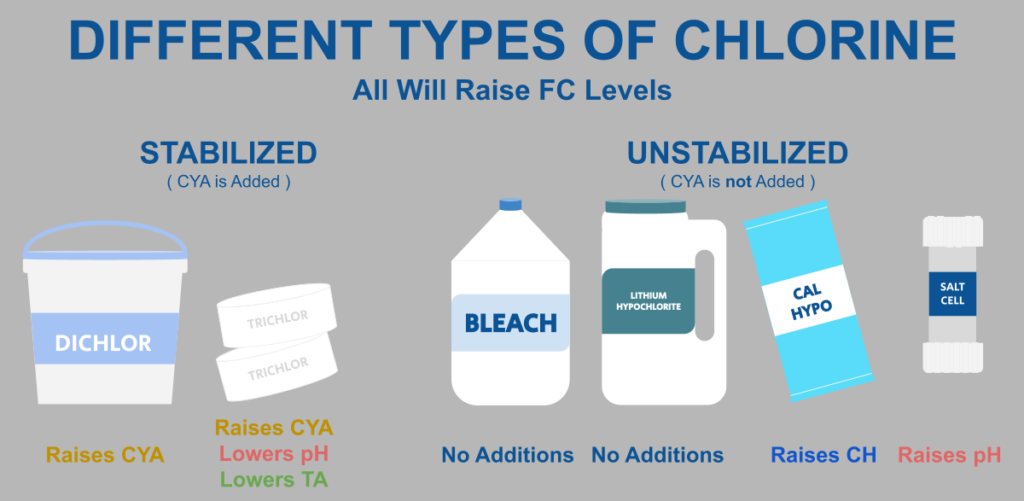
How to Test FC
Ideally, you should test your FC daily or at least every other day. Sunlight and UV rays consume FC so when it is hot and dry out, you might lose 2 to 4 ppm of FC daily!
Your FC levels will depend on how much CYA you have in the water.
How to Increase FC
FC is increased by adding chlorine to your water, whether that is liquid, powder, or puck based
How to Decrease FC
Typically, FC will naturally decrease daily, depending on the weather. Sunny and hot days will decrease FC faster than overcast and cloudy days. Draining and adding water will also cause your FC levels to fluctuate.
Combined Chlorine (CC)
Combined chlorine, often called chloramines, gives you an idea if there is any living organism or contamination in the pool. It looks at the overall reaction of chlorine and any organic material in your pool’s water.
Testing CC
CC should be tested daily along with your FC levels. They are part of the same test if you use a testing kit.
CC levels should be 0.5 ppm or below. Anything above that indicates a problem and needs to be taken care of.
Cyanuric Acid (CYA)
CYA is your chlorine’s stabilizer or protector. It acts as a bodyguard between your FC levels and the sun’s UV rays. Stay on top of your CYA levels and do not let it drift too high.
The more CYA you have in the pool, the more chlorine you need to add for it to work. Conversely, if you have little to no CYA, you’ll need to add chlorine more frequently as the sun will burn through it faster.
It is important to note that some forms of chlorine have CYA added to their chemical makeup. This is known as stabilized chlorine. Trichlor (commonly referred to as pucks or tabs) and dichlor are stabilized forms of chlorine and will add CYA to your water.
Levels must be tested more frequently if trichlor is your primary source of chlorine.
How To Test CYA
CYA can be tested on a weekly or monthly basis. It remains largely unchanged unless fresh water is added to your pool.
Your CYA levels should be between 30-60 ppm. If you have a saltwater chlorine generator (SWG), it should be a little higher, around 60-90 ppm.
How to Increase CYA
CYA is increased by adding cyanuric acid to the pool. It can be found in a powder or liquid form which is a bit more expensive.
CYA takes some time to dissolve so a common way to add CYA is known as the “sock method”. You can take a regular sock, skimmer sock, or nylon panty liner and fill it with the necessary amount of CYA.
Then, take a telescopic pool pole and tie the sock at the end. Place the sock in front of a return jet in the deep end and secure the pole to the decking. After a half hour or so, squeeze the sock and let the CYA granules slowly dissolve out of the sock.
Depending on how much CYA is added, this method will take a couple of hours. You can test 24 hours after CYA has been fully dissolved.
How to Decrease CYA
The most effective and realistic way to lower your CYA levels is to drain and refill with fresh water. There might be some products on the market that claim to decrease CYA but they are largely ineffective and a waste of money.
PH
PH is the overall acidity or basicity of your pool water. PH tends to drift up over some time, and if it is kept unchecked, can cause skin irritation and damage to your equipment due to scaling
How to Test PH
Typically, PH can be tested every week if you know your PH rarely fluctuates. However, PH should be tested daily if you are just starting or you notice some big changes between testing.
PH levels should be between 7.2-8.0, though it is ideal to be around 7.6-7.8
How to Increase PH
pH can be increased using borax in the pool. Aeration (water features and splashing around) can also increase PH over time. So if your PH is a little low, have some pool parties!
How to Decrease PH
Muriatic acid is the preferred method to lowering pH, though you can also use dry acid, and will sometimes be labeled as “PH Down” in big box stores and pool stores. Please use caution and protection when handling these chemicals. Refer to the recommended pool chemicals for proper use.
Total Alkalinity (TA)
Total alkalinity (TA) essentially helps stabilize the PH balance in the pool. Like CYA, ensuring the TA is at the correct range will save a lot of headaches and wild PH fluctuations
Testing TA
TA should be tested whenever you do a PH test to ensure both levels are in the proper ranges.
TA levels should be between 50-90 ppm, but you can let it drift a bit higher if your PH remains stable
How to Increase TA
TA can be increased by using sodium bicarbonate. Luckily, that scientific ingredient is just baking soda that you can find in any grocery store!
How to Decrease TA
Like PH, you can lower TA using muriatic or dry acid. Just be mindful that your PH will also fall here, so have some baking soda ready if your levels drop too much.
Calcium Hardness (CH)
Calcium hardness lets you know how much calcium is in your water. This is more important if you have a plaster pool, as low levels of calcium can force water to get its source from somewhere else, which is usually the plaster itself and the tile grout.
How to Test CH
Testing calcium hardness can be done monthly or weekly with your other tests.
For plaster pools, your CH should be between 200-550 ppm. It doesn’t matter what your level is for vinyl pools, but don’t let it get past 500 ppm.
How to Increase CH
Calcium chloride increases CH, which can be bought in bulk as a de-icer or ice melt. Pool stores will also sell calcium chloride dihydrate which can be a little more expensive.
If you use calcium hypochlorite as a chlorine source, keep in mind that will also increase your CH over time.
How to Decrease CH
There is really only one effective way of lowering your calcium hardness levels: draining and refilling with fresh water. Be sure to note the calcium level of your fill water. If you are in an area with hard water, you might add the calcium back.
Salt
Salt is added to the pool and then gets turned into chlorine using a saltwater generator. It is technically a sanitizer, as saltwater pools are still chlorine pools!
How to Test Salt Levels
Salt levels don’t have to be tested often. You should test whenever you need to add salt, either at the beginning of the season or when you drained the pool.
Salt levels can generally be between 3,000-4,000 ppm, but look at your saltwater generator’s manual for more exact recommendations.
How to Increase Salt Levels
Salt is increased by adding pool salt into the water.
The salt itself should be as pure as possible. It is typically recommended to be >99% pure. Water softener salt can also be used.
How to decrease Salt Levels
Salt can only be decreased by partially draining and refilling the pool with fresh water.
Ideal Pool Chemistry Levels
Each parameter we test must be at a certain level for our water to be truly balanced. If one parameter is too high or too low, that can accelerate the risk of water problems.
Here are the recommended chemistry levels for each parameter.
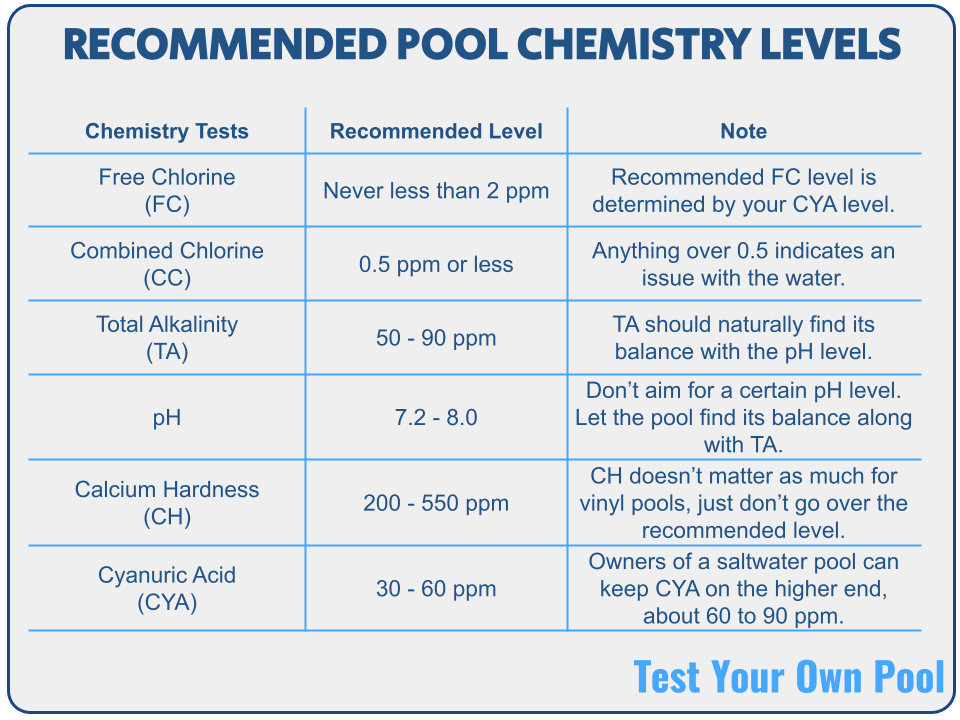
Bottom Line
If you are coming from a pool service or are generally unaware of the chemicals that were being put in your pool, the initial test that you do with your testing kit will give you a really good idea of how your pool was being treated.
You will get familiar with how your pool behaves pretty quickly and because of that, you will not need to test everything all the time. Now get to testing!

